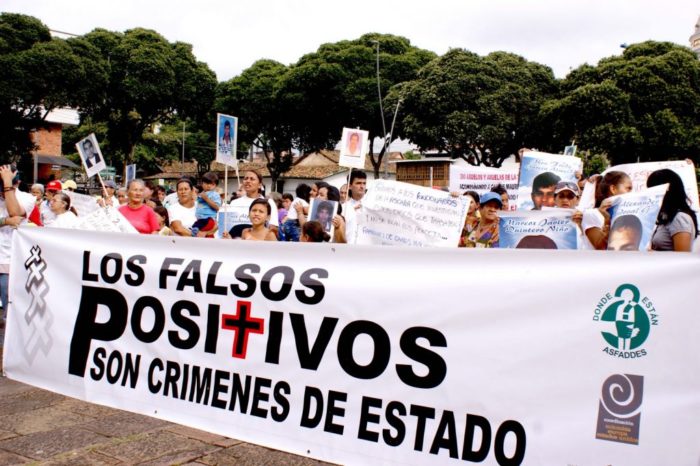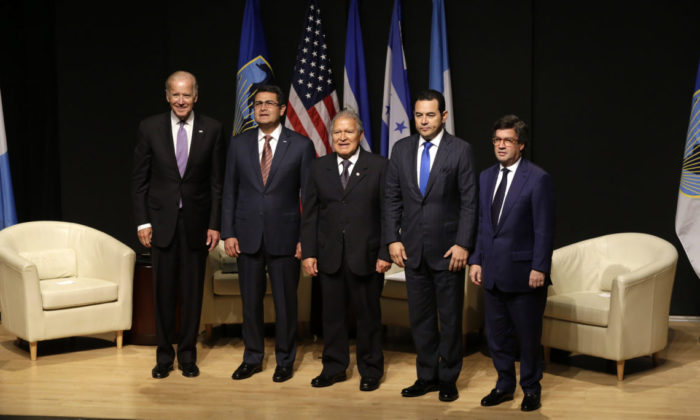With Bernie Sanders’s exit from the presidential race, Joe Biden has become the Democratic Party’s presumptive nominee. The almost-octogenarian old-guard white male has nearly 40 years of seasoning in Washington, stewing in the Beltway’s conventional foreign policy wisdom. It’s a school of thought that overlooks corruption and human rights abuses when it’s convenient, prioritises aid to police and militaries, relies on international development bank loans contingent upon strict austerity measures, and favours corporate-friendly policies which often include natural resource extraction. When it comes to Latin America, Biden’s campaign platform is particularly uninspiring and, indeed, downright damaging.
No one denies that the Trump administration has been uniquely calamitous for Latin America — both with regards to foreign policy and to Latin American migrants who want to make a life in the United States. Trump and his acolytes have caged children, slashed refugee and asylum protections, forced people into dangerously squalid camps in northern Mexico, and detained more migrants in the United States than ever before. They’ve also cut aid to Central America, forced regional governments to receive asylum-seekers when they are clearly unable to offer safety, looked the other way in the face of serious human rights violations and rampant corruption, and emboldened aspiring autocrats like Brazilian President Jair Bolsonaro and Salvadoran President Nayib Bukele to lash out at the media and tighten their grips on power.
Slamming the brakes on these policies must be a priority for a Democratic administration, but it won’t be nearly enough. If Biden wins the nomination and the presidency, he will also face a region suffering the impact of the novel coronavirus (spread, in some cases, by deportations from the United States) and crippled by economic recession, as well as the drying up of remittances from outside.
Yet Biden, in promising a return to what he recalls as the golden days of the Obama administration in which he served, and in touting that administration’s approach to migration and the region’s multifaceted crises, all while reaching further back to claim credit for the multibillion-dollar anti-drug campaign Plan Colombia, offers a return to a status quo that was rank with its own problems. Biden’s rubric of stratagems may not be as bitterly cruel as those of the Trump administration, but it still supports short-term American interests, overlooks serious human rights abuses, relies on militarized “security” responses to instability, and promotes an extractive neoliberal agenda.
Biden’s plan for Central America — one of 28 “bold ideas” featured on his campaign website — dressed up in left-tilting rhetoric for primary season, harkens back to the same, often failing and sometimes flailing, strategies he espoused as vice president and as a senator.
As Biden put it to Politico in 2014, “The only thing I know is I ain’t changing my brand.” Nowhere is that clearer than in Latin America.
"The Guy Who Put Together Plan Colombia"
Though a senator since 1973, Joe Biden only began marking his “brand” in Latin America with Plan Colombia, a massive foreign and military aid package aimed at taking down the illegal drug trade that was signed into law by Bill Clinton in 2000. Biden championed the legislation as member of the Senate Foreign Relations Committee, and, in a way, the plan was a continuation of the anti-drug measures he’d promoted throughout the 1980s as a member of the Judiciary Committee. Domestically, as a tough-on-crime senator, Biden pushed for more policing, even criticizing Reagan for not locking up enough people.
In Latin America, efforts Biden backed played out as whack-a-mole strategies, with the Drug Enforcement Agency and international partners chasing drug traffickers from one route to another, but doing little to curb total production, demand, or the northward flow of drugs. Plan Colombia only increased the emphasis on a heavy-handed, militarized response to the drug problem, pushing production and trafficking routes from more isolated to more populated parts of Colombia. As Steven D. Cohen put it recently in The Baffler, “Plan Colombia was in effect to Global South pacification what the 1994 crime bill had been to domestic policing.”
This past January, during a primary campaign stop, Biden said to the Des Moines Register, “I’m the guy who put together Plan Colombia,” which, given the legacy of the plan, might sound like a confession, but was certainly meant as a boast. Though it effectively achieved none of its original objectives, the plan continues to be lauded by some American politicians, including Biden, as an exemplary success — embodying the establishment’s tunnel-vision focus on military expenditures and open markets. John Kerry called Colombia, in reference to the plan, “one of the great stories of Latin America.” The plan has also served as a model for other such “security” policies throughout the region: in Mexico and in Guatemala, Honduras, and El Salvador, the northern triangle of Central America.
María Teresa Ronderos, a Colombian journalist who has written extensively on politics and war in the country, told me the plan was “a disaster — not something to be proud about.” Dawn Paley, author of “Drug War Capitalism,” explained that the plan was a “success” only in “in terms of opening up the country’s economy and laying the groundwork for the Colombia–U.S. Free Trade Agreement,” which was signed in 2006. In perhaps the most obvious sign of failure, after the implementation of the plan, cocaine flowed northward at higher rates and lower prices than ever before.
The other clear result was an increase in violence: Between 2003 and 2007, the Colombian army, funded and emboldened by the United States, killed thousands of civilians and falsely claimed they were guerrilla soldiers killed in combat, in what became known as the “false positives” scandal. During the same period, as John Lindsay-Poland, author of “Plan Colombia,” explained, more than 7 million Colombians were displaced by the armed conflict. “These human costs were never part of the policy calculus for Joe Biden,” Lindsay-Poland said.

From 2000 to 2008, as Paley recounts in her book, “the Colombian military received $4.9 billion worth of U.S. State Department and Defense Department assistance, the majority of which was provided under the rubric of Plan Colombia.” Paley also notes that the CIA operated in the country with a “multibillion-dollar black budget,” and that “battalions of the Colombian army were trained to protect oil pipelines belonging to U.S. companies.” During the same period, there were more homicides counted than ever before in the nation’s history.
“If it was meant to put an end to the guerrilla armies, it wasn’t effective. If it was a plan to stop drug trafficking, it just pushed [trafficking] to more populated areas, which was overall worse for Colombia,” Ronderos told me.
Besides its anti-narcotics focus, Plan Colombia also helped speed along privatization and other neoliberal reforms. The International Monetary Fund, along with the World Bank, began working in Colombia to restructure its economy in 1990; in the following decade, the unemployment rate went from just over 10 percent to nearly 20 percent. In 1999, the IMF loaned the country $2.9 billion dollars that was contingent on strict austerity measures, including “severe cutbacks in public investment in basic social services-health care, education and social security.” Another $2.1 billion loan went through in 2003, along with another wave of austerity measures, including “the restructuring of the pension program, cuts to the public sector workforce, and the privatization of a major bank,” Paley wrote. (While not officially a part of Plan Colombia, the Colombian government leveraged the plan to push for the IMF loan.)
Paley also traces the benefits reaped from the plan by palm oil companies, mining companies, and major transnational corporations like Chiquita. Lower-class and especially rural Colombians saw little to none of those benefits, and millions of hectares of land were stolen from mostly Indigenous communities. In 2020, Biden is again promoting, via his campaign platform, the so-called development banks as a key part of his Latin America policy, calling on the World Bank to prime Latin American countries to engage “with the private sector” and “promote foreign investment.” And he’s proudly claiming Plan Colombia as something that “strengthened that government out for a long while,” even as the country continues to teeter on the edge of war and the peace process signed in 2016 continues to unravel. In 2019, according to the U.N., there were between 107 and 120 human rights defenders killed in Colombia.
Alliance for Prosperity
The other major Latin American policy that, despite its towering failures, Biden boasts of being an architect of, was called the Alliance for Prosperity. It came in 2014, on the heels of an increase in the arrival of Central American children at the U.S.-Mexico border, many of whom came alone, seeking asylum. Biden referred to the children at the time as a “dangerous surge of migration.” Dana Frank, professor emerita of history at University of California Santa Cruz and an expert on Honduras, sees that framing as “fanning the flames of hysteria, and setting the stage for Trump” to invoke anti-immigration sentiment and ride it to victory in 2016.
Biden was dispatched by Obama to address the crisis and responded by requesting a billion dollars to supposedly tackle the root causes of migration from El Salvador, Guatemala, and Honduras. The money — $750 million was eventually approved — primarily went to security assistance, which increased from $161 million in 2015 to $252 million in 2016. As Alexander Main, of the Center for Economic Policy Research, put it, the money was for “increasingly militarized police forces and military forces involved in countless human rights abuses, including the assassination of activists like Berta Cáceres in Honduras,” which involved at least three active and retired military officials.
Frank sees the aid as “just a front for how U.S. officials want to shore up these regimes … basically giving even more money to the perpetrators.” She pointed out that there’s no way Biden and others in the U.S. government didn’t know about rampant corruption in the region. Juan Orlando Hernández, elected as president of Honduras in disputed elections in 2013, for example, has since been accused by U.S. prosecutors of taking drug money for both his 2013 and 2017 election campaigns. His brother has been charged with drug trafficking, his wife has been implicated, and Mexican drug kingpin Joaquín “El Chapo” Guzmán allegedly gave him $1 million in exchange for protection. In 2014, in celebration of the Alliance for Prosperity, Biden, bearing his signature alligator grin, posed with Hernández and the presidents of Guatemala and El Salvador. Biden and Hernández were both giving thumbs-up. (Last August, Biden called Venezuelan president Nicolas Maduro “a tyrant, who has stolen elections, abused his authority, allowed his cronies to enrich themselves.” He has offered no such condemnation of Honduras president Hernández, who has done all of the same.)
 U.S. Vice President Joe Biden along with Northern Triangle Presidents. Image: US Embassy in El Salvador.
U.S. Vice President Joe Biden along with Northern Triangle Presidents. Image: US Embassy in El Salvador.
Despite an ongoing exodus from the region, Biden claims that “the Biden approach” to Central America “reduced violence and helped to ensure that families and children remained in their home countries.” Though emigration from Central America dipped briefly in 2015, it has continued at 2014 levels or higher ever since, with record numbers of people seeking asylum since 2014. Asylum claims at the southern border increased fourfold from 2014 to 2017. And while some statistics point to a decrease in homicides in Honduras, for example, Peter Hakim, president emeritus and a senior fellow at the Inter-American Dialogue, is dubious of that accounting. “They fudged figures in the election,” he said. “Why couldn’t they fudge homicide statistics?”
“Particularly troubling,” Main of CEPR told me, “is the fact that according to a recent Government Accountability Office (GAO) report, there has been ‘no real assessment of outcomes’ for most of the over $2 billion worth of U.S. assistance programs since 2013, and the few assessments that the GAO obtained showed, at best, ‘mixed results.’” CEPR showed in a 2016 report that the one study frequently pointed to as proof of a positive outcome from security aid was “based on flawed statistical analysis, and its findings therefore had no validity.”
Still, in 2020, the Biden campaign proposes more of the same: a four-year, $4 billion investment plan for Central America, with a few new details thrown in. In acknowledging the destabilizing and migration-driving effects of climate change in the region, for example, the only response the Biden plan offers is support for unspecified “clean energy” and a vague throwaway line about “adaptation and resilience.” This relegates one of the most severe problems in the region — a ravaging years-long drought that is pushing huge tracts of Central America to desperation — to an imprecise talking point.
As with Colombia, Biden claims the World Bank and the Inter-American Development Bank can develop infrastructure in the region. To cite Honduras again, the country has relied on multimillion-dollar loans contingent on austerity before, with the government using the money to build infrastructure for export-oriented sweatshops that have since spawned gang-ruled slums in their circumference. Honduras also succumbed to IMF pressure to privatize energy companies. In 2019, “many people are leaving Honduras in part because their electrical bills have shot up dramatically,” Frank told me.
It’s also revealing to look at what’s not in Biden’s current proposal for Central America. “There is nothing in there about the enormous human rights crisis, and little to offer about building a functional state that should provide health care and other basic services. It’s all about extraction,” Frank said. Biden, she said, “has been a key cause in producing and exacerbating the very problems he is now claiming to address.”
Migration
Any assessment of foreign policy in Latin America cannot ignore U.S. immigration policy. Remittances from Salvadoran and Honduran migrants living in the United States account for around 20 percent of each countries’ GDP. Overall, hundreds of thousands of migrants are deported to the region every year, and hundreds of thousands also migrate to or toward the United States. Migration from the Northern Triangle “cannot be effectively addressed if solutions only focus on our southern border,” another “bold idea” from Biden’s 2020 campaign website correctly remarks.
But Biden’s ideas for what lies beyond the southern border still prioritize stopping migration over improving lives. Along with the Alliance for Prosperity, the Obama administration pushed Mexico to establish the Programa Frontera Sur, funding and inciting Mexican officials to crack down heavily on Central American migrants in southern Mexico. As a result, migrants were pushed into more dangerous territory, where notoriously abusive Mexican agents hounded, arrested, abused, and sometimes killed them with blanket impunity. (Trump took a similar approach, though he has threatened rather than funded the Mexican government to crack down on U.S.-bound migration.)
At the same time, though deportations from the United States dropped in 2014 and 2015, there were still significantly more deportations under Obama and Biden than during any other administration. If Obama was the deporter-in-chief, as critics and immigrant rights activists took to calling him, Biden was his deputy. While Trump has deported fewer people in his first three years in office than the same period under Obama, he has locked up significantly more. And yet, as Christina Fialho, co-founder and co-executive director of Freedom for Immigrants, has said “The expansion of immigration detention since the early 1980s has been a bipartisan initiative. Where we are today is the result of three decades of increasingly aggressive policies under both parties’ leadership.”
Silky Shah, executive director of the Detention Watch Network, emphasized the fact that “the Obama administration greatly increased the immigration detention infrastructure.”
“It doesn’t have to be this way,” Shah added. “With Covid-19, the demand to end immigration detention has become clearer and more urgent. The billions of taxpayer dollars used to fund ICE’s detention system should instead be used to fund critical healthcare, education, and housing programs that support our collective wellbeing.”
As Shah’s comment reflects, the Democratic Party during Trump’s presidency has moved left on immigration, and Biden has tried to claim that he has too. His campaign website states that as president, he would “immediately do away with the Trump Administration’s draconian immigration policies,” listing off the so-called Migrant Protection Protocols, asylum bans, family separation, and expanded detention among other policies he plans to end. In the last debate with Sanders, he committed to a temporary moratorium on deportations.
But the anti-immigration momentum built up by the Trump administration — with immigration judges, the Supreme Court, and attorneys general locking in xenophobic policies; the continued construction of wall and fencing infrastructure along the southern border; and an emboldened ICE and Border Patrol — cannot be “immediately” done away with. And given Biden’s history, advocates are sceptical that he will carry through with his left-leaning promises.
“If we truly want to be a country that lives by its values of ‘liberty and justice for all,’ we cannot just undo the Trump administration’s policies or revert to the Obama administration’s policies. We must end the whole system,” Fialho added. Building a more just and human system of immigration will require ideas outside the Biden brand.
The same is true of foreign policy. As Paley put it, “Biden’s plan represents the continuation of the same model of military and private sector intervention in Central America that has displaced and harmed so many.” While there’s nothing bold in his plans for Latin America, there is plenty that is old, and Biden’s position is clear: He promises more Biden.
This article was first published by The Latin American Bureau. For more great articles visit: www.lab.org uk


















